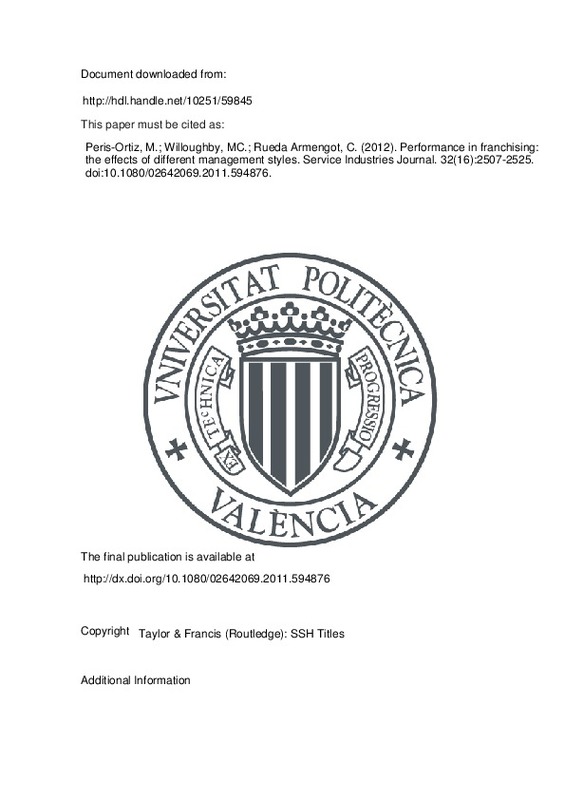Altinay, L., & Okumus, F. (2010). Franchise partner selection decision making. The Service Industries Journal, 30(6), 929-946. doi:10.1080/02642060802322275
Child, J. (1972). Organizational Structure, Environment and Performance: The Role of Strategic Choice. Sociology, 6(1), 1-22. doi:10.1177/003803857200600101
Combs, J. G., & Ketchen, D. J. (1999). CAN CAPITAL SCARCITY HELP AGENCY THEORY EXPLAIN FRANCHISING? REVISITING THE CAPITAL SCARCITY HYPOTHESIS. Academy of Management Journal, 42(2), 196-207. doi:10.2307/257092
[+]
Altinay, L., & Okumus, F. (2010). Franchise partner selection decision making. The Service Industries Journal, 30(6), 929-946. doi:10.1080/02642060802322275
Child, J. (1972). Organizational Structure, Environment and Performance: The Role of Strategic Choice. Sociology, 6(1), 1-22. doi:10.1177/003803857200600101
Combs, J. G., & Ketchen, D. J. (1999). CAN CAPITAL SCARCITY HELP AGENCY THEORY EXPLAIN FRANCHISING? REVISITING THE CAPITAL SCARCITY HYPOTHESIS. Academy of Management Journal, 42(2), 196-207. doi:10.2307/257092
Combs, J. (2003). Why Do Firms Use Franchising as an Entrepreneurial Strategy?: A Meta-Analysis. Journal of Management, 29(3), 443-465. doi:10.1016/s0149-2063(03)00019-9
COMBS, J. G., KETCHEN, D. J., & IRELAND, R. D. (2006). Effectively managing service chain organizations. Organizational Dynamics, 35(4), 357-371. doi:10.1016/j.orgdyn.2006.08.006
Combs, J. G., Michael, S. C., & Castrogiovanni, G. J. (2009). Institutional Influences on the Choice of Organizational Form: The Case of Franchising. Journal of Management, 35(5), 1268-1290. doi:10.1177/0149206309336883
Crook, T. R., Shook, C. L., Madden, T. M., & Morris, M. L. (2009). A review of current construct measurement in entrepreneurship. International Entrepreneurship and Management Journal, 6(4), 387-398. doi:10.1007/s11365-009-0114-7
Fama, E. F., & Jensen, M. C. (1983). Agency Problems and Residual Claims. The Journal of Law and Economics, 26(2), 327-349. doi:10.1086/467038
Fama, E. F., & Jensen, M. C. (1983). Separation of Ownership and Control. The Journal of Law and Economics, 26(2), 301-325. doi:10.1086/467037
Gillis, W. E., & Combs, J. G. (2009). Franchisor strategy and firm performance: Making the most of strategic resource investments. Business Horizons, 52(6), 553-561. doi:10.1016/j.bushor.2009.07.001
Gouldner, A. W. (1960). The Norm of Reciprocity: A Preliminary Statement. American Sociological Review, 25(2), 161. doi:10.2307/2092623
Gupta, A. K., Smith, K. G., & Shalley, C. E. (2006). The Interplay Between Exploration and Exploitation. Academy of Management Journal, 49(4), 693-706. doi:10.5465/amj.2006.22083026
Hambrick, D. C. (2007). Upper Echelons Theory: An Update. Academy of Management Review, 32(2), 334-343. doi:10.5465/amr.2007.24345254
Hambrick, D. C., & Mason, P. A. (1984). Upper Echelons: The Organization as a Reflection of Its Top Managers. The Academy of Management Review, 9(2), 193. doi:10.2307/258434
Hindle, K., & Moroz, P. (2009). Indigenous entrepreneurship as a research field: developing a definitional framework from the emerging canon. International Entrepreneurship and Management Journal, 6(4), 357-385. doi:10.1007/s11365-009-0111-x
Jensen, M. C., & Meckling, W. H. (1976). Theory of the firm: Managerial behavior, agency costs and ownership structure. Journal of Financial Economics, 3(4), 305-360. doi:10.1016/0304-405x(76)90026-x
Jensen, M. C., & Heckling, W. H. (1995). SPECIFIC AND GENERAL KNOWLEDGE, AND ORGANIZATIONAL STRUCTURE. Journal of Applied Corporate Finance, 8(2), 4-18. doi:10.1111/j.1745-6622.1995.tb00283.x
Klein, B., Crawford, R. G., & Alchian, A. A. (1978). Vertical Integration, Appropriable Rents, and the Competitive Contracting Process. The Journal of Law and Economics, 21(2), 297-326. doi:10.1086/466922
Liu, W., Lepak, D. P., Takeuchi, R., & Sims, H. P. (2003). Matching leadership styles with employment modes: strategic human resource management perspective. Human Resource Management Review, 13(1), 127-152. doi:10.1016/s1053-4822(02)00102-x
March, J. G. (1991). Exploration and Exploitation in Organizational Learning. Organization Science, 2(1), 71-87. doi:10.1287/orsc.2.1.71
Mitsuhashi, H., Shane, S., & Sine, W. D. (2008). Organization governance form in franchising: efficient contracting or organizational momentum? Strategic Management Journal, 29(10), 1127-1136. doi:10.1002/smj.702
Orlikowski, W. J. (1992). The Duality of Technology: Rethinking the Concept of Technology in Organizations. Organization Science, 3(3), 398-427. doi:10.1287/orsc.3.3.398
Ouchi, W. G. (1980). Markets, Bureaucracies, and Clans. Administrative Science Quarterly, 25(1), 129. doi:10.2307/2392231
Gómez, R. S., González, I. S., & Vázquez, L. (2009). Multi-unit versus single-unit franchising: assessing why franchisors use different ownership strategies. The Service Industries Journal, 30(3), 463-476. doi:10.1080/02642060802252027
Gómez, R. S., González, I. S., & Suárez, L. V. (2011). Service quality control mechanisms in franchise networks. The Service Industries Journal, 31(5), 713-723. doi:10.1080/02642060902833338
Sarkees, M., & Hulland, J. (2009). Innovation and efficiency: It is possible to have it all. Business Horizons, 52(1), 45-55. doi:10.1016/j.bushor.2008.08.002
Sebora, T. C., & Theerapatvong, T. (2009). Corporate entrepreneurship: a test of external and internal influences on managers’ idea generation, risk taking, and proactiveness. International Entrepreneurship and Management Journal, 6(3), 331-350. doi:10.1007/s11365-009-0108-5
Shane, S., & Foo, M.-D. (1999). New Firm Survival: Institutional Explanations for New Franchisor Mortality. Management Science, 45(2), 142-159. doi:10.1287/mnsc.45.2.142
Shane, S., Shankar, V., & Aravindakshan, A. (2006). The Effects of New Franchisor Partnering Strategies on Franchise System Size. Management Science, 52(5), 773-787. doi:10.1287/mnsc.1050.0449
Shane, S. A. (1996). HYBRID ORGANIZATIONAL ARRANGEMENTS AND THEIR IMPLICATIONS FOR FIRM GROWTH AND SURVIVAL: A STUDY OF NEW FRANCHISORS. Academy of Management Journal, 39(1), 216-234. doi:10.2307/256637
Shane, S. (2001). Organizational Incentives and Organizational Mortality. Organization Science, 12(2), 136-160. doi:10.1287/orsc.12.2.136.10108
Tihula, S., & Huovinen, J. (2009). Incidence of teams in the firms owned by serial, portfolio and first-time entrepreneurs. International Entrepreneurship and Management Journal, 6(3), 249-260. doi:10.1007/s11365-008-0101-4
TSUI, A. S., PEARCE, J. L., PORTER, L. W., & TRIPOLI, A. M. (1997). ALTERNATIVE APPROACHES TO THE EMPLOYEE-ORGANIZATION RELATIONSHIP: DOES INVESTMENT IN EMPLOYEES PAY OFF? Academy of Management Journal, 40(5), 1089-1121. doi:10.2307/256928
Valliere, D. (2008). Reconceptualizing entrepreneurial framework conditions. International Entrepreneurship and Management Journal, 6(1), 97-112. doi:10.1007/s11365-008-0077-0
Vázquez, L. (2009). How passive ownership restrictions affect the rate of franchisee failure. The Service Industries Journal, 29(6), 847-859. doi:10.1080/02642060902749419
Wakkee, I., Elfring, T., & Monaghan, S. (2008). Creating entrepreneurial employees in traditional service sectors. International Entrepreneurship and Management Journal, 6(1), 1-21. doi:10.1007/s11365-008-0078-z
Weick, K. E., & Roberts, K. H. (1993). Collective Mind in Organizations: Heedful Interrelating on Flight Decks. Administrative Science Quarterly, 38(3), 357. doi:10.2307/2393372
Williamson, O. E. (1993). Calculativeness, Trust, and Economic Organization. The Journal of Law and Economics, 36(1, Part 2), 453-486. doi:10.1086/467284
Winter, S. G. (2000). The Satisficing Principle in Capability Learning. Strategic Management Journal, 21(10-11), 981-996. doi:10.1002/1097-0266(200010/11)21:10/11<981::aid-smj125>3.0.co;2-4
Winter, S. G. (2003). Understanding dynamic capabilities. Strategic Management Journal, 24(10), 991-995. doi:10.1002/smj.318
Yin, X., & Zajac, E. J. (2004). The strategy/governance structure fit relationship: theory and evidence in franchising arrangements. Strategic Management Journal, 25(4), 365-383. doi:10.1002/smj.389
[-]







![[Cerrado]](/themes/UPV/images/candado.png)


